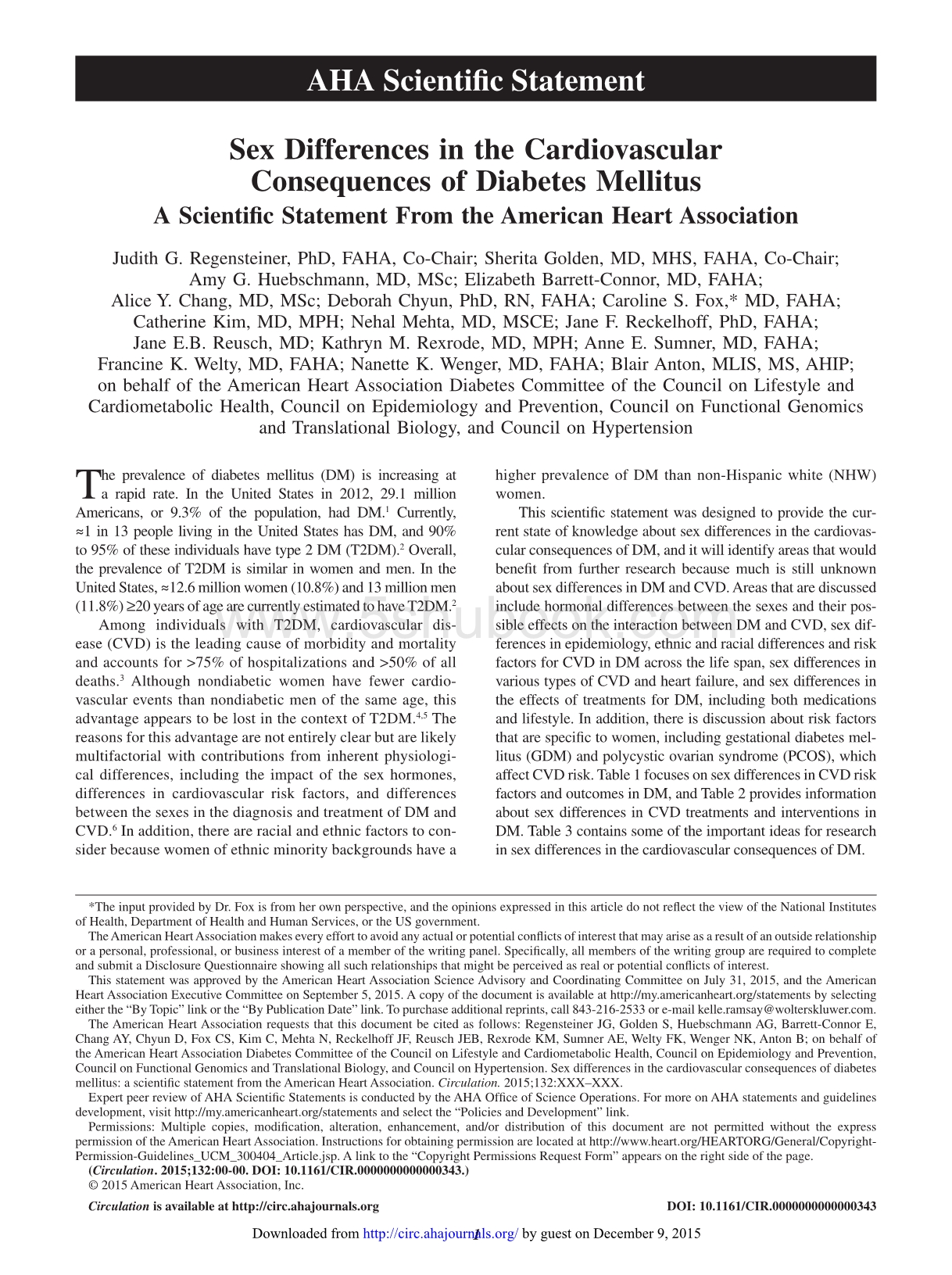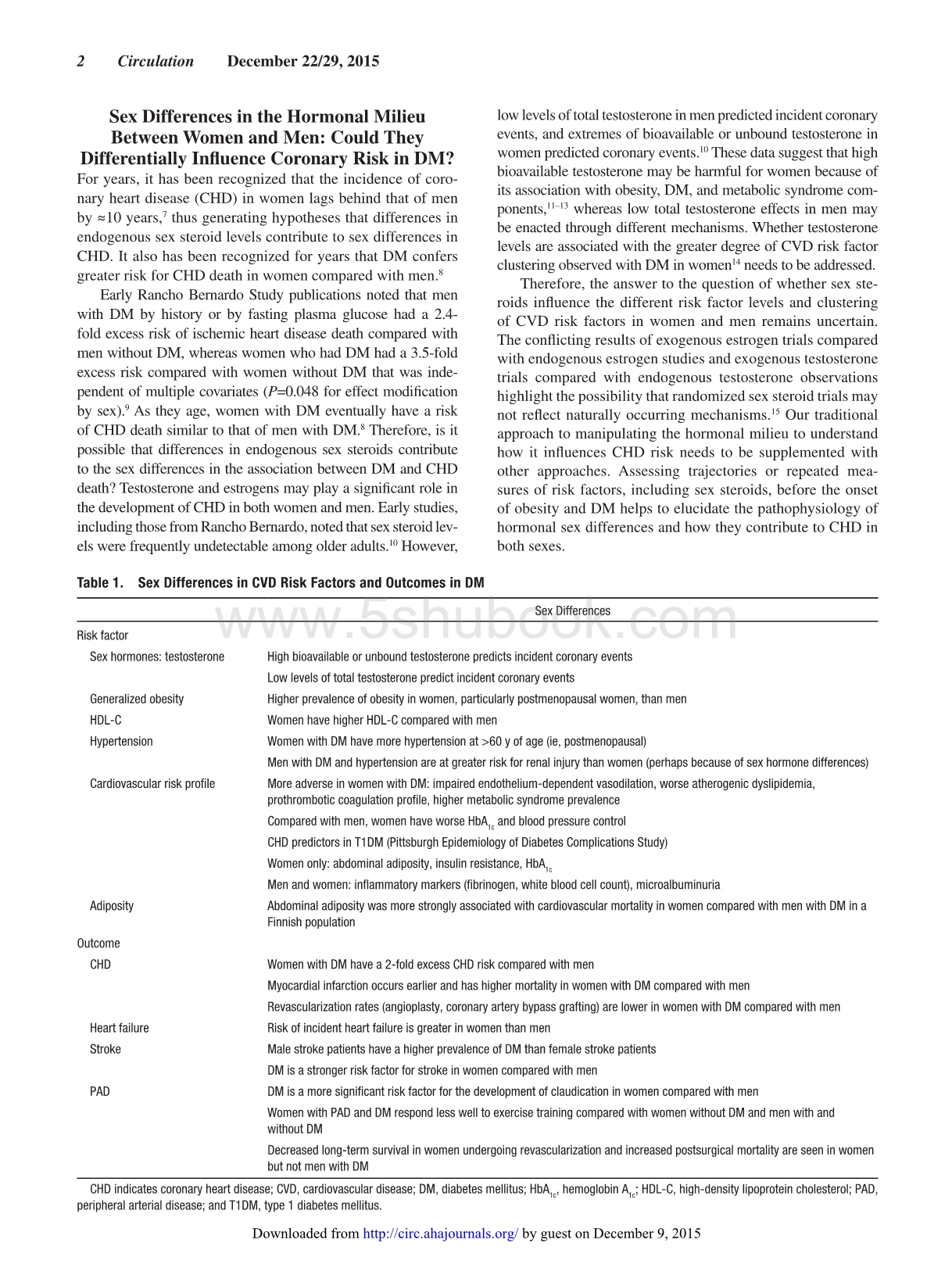
 【医脉通-指南】2015+AHA科学声明:糖尿病心血管结局的性别差异(英文版).pdf(25页)
【医脉通-指南】2015+AHA科学声明:糖尿病心血管结局的性别差异(英文版).pdf(25页)
《【医脉通-指南】2015+AHA科学声明:糖尿病心血管结局的性别差异(英文版).pdf(25页)》由会员分享,可在线阅读,更多相关《【医脉通-指南】2015+AHA科学声明:糖尿病心血管结局的性别差异(英文版).pdf(25页)(25页珍藏版)》请在周易易学书店|道易五术书社上搜索。
1、AHA Scientific Statement1The prevalence of diabetes mellitus(DM)is increasing at a rapid rate.In the United States in 2012,29.1 million Americans,or 9.3%of the population,had DM.1 Currently,1 in 13 people living in the United States has DM,and 90%to 95%of these individuals have type 2 DM(T2DM).2 Ove
2、rall,the prevalence of T2DM is similar in women and men.In the United States,12.6 million women(10.8%)and 13 million men(11.8%)20 years of age are currently estimated to have T2DM.2Among individuals with T2DM,cardiovascular dis-ease(CVD)is the leading cause of morbidity and mortality and accounts fo
3、r 75%of hospitalizations and 50%of all deaths.3 Although nondiabetic women have fewer cardio-vascular events than nondiabetic men of the same age,this advantage appears to be lost in the context of T2DM.4,5 The reasons for this advantage are not entirely clear but are likely multifactorial with cont
4、ributions from inherent physiologi-cal differences,including the impact of the sex hormones,differences in cardiovascular risk factors,and differences between the sexes in the diagnosis and treatment of DM and CVD.6 In addition,there are racial and ethnic factors to con-sider because women of ethnic
5、 minority backgrounds have a higher prevalence of DM than non-Hispanic white(NHW)women.This scientific statement was designed to provide the cur-rent state of knowledge about sex differences in the cardiovas-cular consequences of DM,and it will identify areas that would benefit from further research
6、 because much is still unknown about sex differences in DM and CVD.Areas that are discussed include hormonal differences between the sexes and their pos-sible effects on the interaction between DM and CVD,sex dif-ferences in epidemiology,ethnic and racial differences and risk factors for CVD in DM a
7、cross the life span,sex differences in various types of CVD and heart failure,and sex differences in the effects of treatments for DM,including both medications and lifestyle.In addition,there is discussion about risk factors that are specific to women,including gestational diabetes mel-litus(GDM)an
8、d polycystic ovarian syndrome(PCOS),which affect CVD risk.Table 1 focuses on sex differences in CVD risk factors and outcomes in DM,and Table 2 provides information about sex differences in CVD treatments and interventions in DM.Table 3 contains some of the important ideas for research in sex differ
9、ences in the cardiovascular consequences of DM.(Circulation.2015;132:00-00.DOI:10.1161/CIR.0000000000000343.)2015 American Heart Association,Inc.Circulation is available at http:/circ.ahajournals.org DOI:10.1161/CIR.0000000000000343*The input provided by Dr.Fox is from her own perspective,and the op
10、inions expressed in this article do not reflect the view of the National Institutes of Health,Department of Health and Human Services,or the US government.The American Heart Association makes every effort to avoid any actual or potential conflicts of interest that may arise as a result of an outside
11、 relationship or a personal,professional,or business interest of a member of the writing panel.Specifically,all members of the writing group are required to complete and submit a Disclosure Questionnaire showing all such relationships that might be perceived as real or potential conflicts of interes
12、t.This statement was approved by the American Heart Association Science Advisory and Coordinating Committee on July 31,2015,and the American Heart Association Executive Committee on September 5,2015.A copy of the document is available at http:/my.americanheart.org/statements by selecting either the“
13、By Topic”link or the“By Publication Date”link.To purchase additional reprints,call 843-216-2533 or e-mail.The American Heart Association requests that this document be cited as follows:Regensteiner JG,Golden S,Huebschmann AG,Barrett-Connor E,Chang AY,Chyun D,Fox CS,Kim C,Mehta N,Reckelhoff JF,Reusch
14、 JEB,Rexrode KM,Sumner AE,Welty FK,Wenger NK,Anton B;on behalf of the American Heart Association Diabetes Committee of the Council on Lifestyle and Cardiometabolic Health,Council on Epidemiology and Prevention,Council on Functional Genomics and Translational Biology,and Council on Hypertension.Sex d
15、ifferences in the cardiovascular consequences of diabetes mellitus:a scientific statement from the American Heart Association.Circulation.2015;132:XXXXXX.Expert peer review of AHA Scientific Statements is conducted by the AHA Office of Science Operations.For more on AHA statements and guidelines dev
16、elopment,visit http:/my.americanheart.org/statements and select the“Policies and Development”link.Permissions:Multiple copies,modification,alteration,enhancement,and/or distribution of this document are not permitted without the express permission of the American Heart Association.Instructions for o
17、btaining permission are located at http:/www.heart.org/HEARTORG/General/Copyright-Permission-Guidelines_UCM_300404_Article.jsp.A link to the“Copyright Permissions Request Form”appears on the right side of the page.Sex Differences in the Cardiovascular Consequences of Diabetes MellitusA Scientific St
18、atement From the American Heart AssociationJudith G.Regensteiner,PhD,FAHA,Co-Chair;Sherita Golden,MD,MHS,FAHA,Co-Chair;Amy G.Huebschmann,MD,MSc;Elizabeth Barrett-Connor,MD,FAHA;Alice Y.Chang,MD,MSc;Deborah Chyun,PhD,RN,FAHA;Caroline S.Fox,*MD,FAHA;Catherine Kim,MD,MPH;Nehal Mehta,MD,MSCE;Jane F.Reck
19、elhoff,PhD,FAHA;Jane E.B.Reusch,MD;Kathryn M.Rexrode,MD,MPH;Anne E.Sumner,MD,FAHA;Francine K.Welty,MD,FAHA;Nanette K.Wenger,MD,FAHA;Blair Anton,MLIS,MS,AHIP;on behalf of the American Heart Association Diabetes Committee of the Council on Lifestyle and Cardiometabolic Health,Council on Epidemiology a
20、nd Prevention,Council on Functional Genomics and Translational Biology,and Council on Hypertension by guest on December 9,2015 http:/circ.ahajournals.org/Downloaded from 2 Circulation December 22/29,2015Sex Differences in the Hormonal Milieu Between Women and Men:Could They Differentially Influence
21、Coronary Risk in DM?For years,it has been recognized that the incidence of coro-nary heart disease(CHD)in women lags behind that of men by 10 years,7 thus generating hypotheses that differences in endogenous sex steroid levels contribute to sex differences in CHD.It also has been recognized for year
22、s that DM confers greater risk for CHD death in women compared with men.8Early Rancho Bernardo Study publications noted that men with DM by history or by fasting plasma glucose had a 2.4-fold excess risk of ischemic heart disease death compared with men without DM,whereas women who had DM had a 3.5-
23、fold excess risk compared with women without DM that was inde-pendent of multiple covariates(P=0.048 for effect modification by sex).9 As they age,women with DM eventually have a risk of CHD death similar to that of men with DM.8 Therefore,is it possible that differences in endogenous sex steroids c
24、ontribute to the sex differences in the association between DM and CHD death?Testosterone and estrogens may play a significant role in the development of CHD in both women and men.Early studies,including those from Rancho Bernardo,noted that sex steroid lev-els were frequently undetectable among old
25、er adults.10 However,low levels of total testosterone in men predicted incident coronary events,and extremes of bioavailable or unbound testosterone in women predicted coronary events.10 These data suggest that high bioavailable testosterone may be harmful for women because of its association with o



- 配套讲稿:
如PPT文件的首页显示word图标,表示该PPT已包含配套word讲稿。双击word图标可打开word文档。
- 特殊限制:
部分文档作品中含有的国旗、国徽等图片,仅作为作品整体效果示例展示,禁止商用。设计者仅对作品中独创性部分享有著作权。
- 关 键 词:
- 医脉通-指南 医脉通 指南 aha 科学 声明 糖尿病 心血管 结局 终局 性别差异 英文
 周易易学书店|道易五术书社所有资源均是用户自行上传分享,仅供网友学习交流,未经上传用户书面授权,请勿作他用。
周易易学书店|道易五术书社所有资源均是用户自行上传分享,仅供网友学习交流,未经上传用户书面授权,请勿作他用。









 《风湿病中医特色治疗》·吴启富.pdf(342页)
《风湿病中医特色治疗》·吴启富.pdf(342页)
 【2016爱爱医中医擂台赛】:协定处方院内验方 院内制剂汇集(骨伤科类)天津市中医院.doc(2页)
【2016爱爱医中医擂台赛】:协定处方院内验方 院内制剂汇集(骨伤科类)天津市中医院.doc(2页)
 穴位贴敷疗法(中医特色治疗).ppt(14页)
穴位贴敷疗法(中医特色治疗).ppt(14页)
